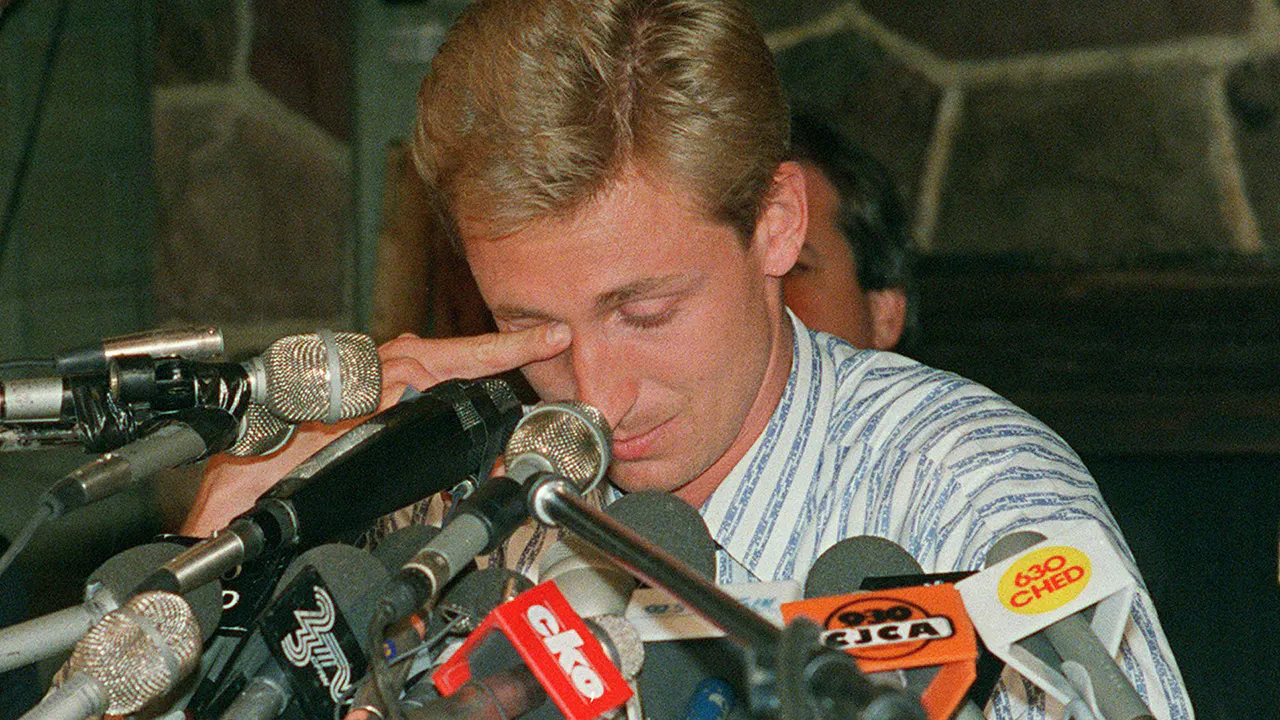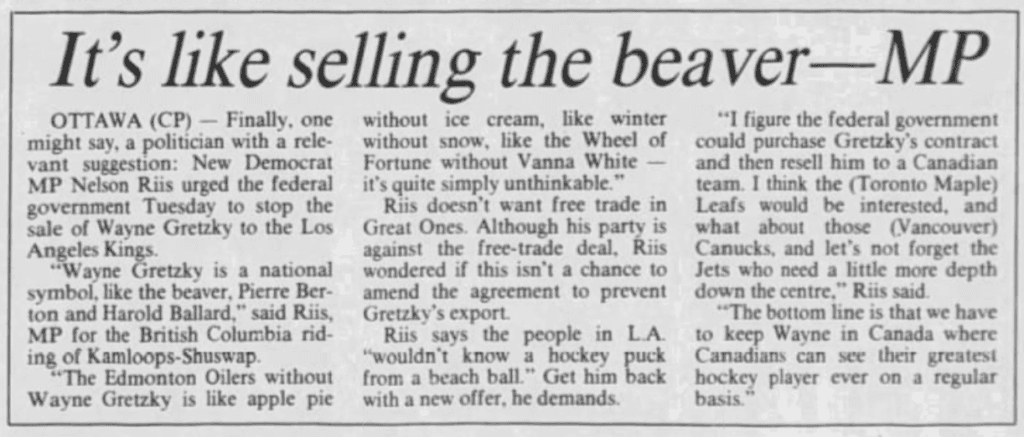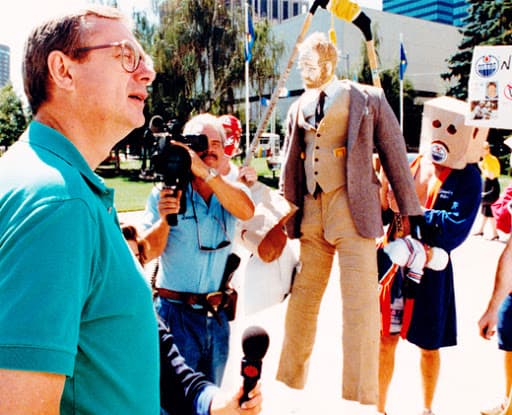Nation Sites
The Nation Network
OilersNation has no direct affiliation to the Edmonton Oilers, Oilers Entertainment Group, NHL, or NHLPA
Worst Oilers Trades Countdown – No. 1: Wayne Gretzky gets sold to Los Angeles

Photo credit: The Canadian Press
It’s known as The Trade, which is somewhat disingenuous. It was really a sale.
Peter Pocklington sold high on his investment and made himself a boatload of cash in the process. A decade after buying Wayne Gretzky from Nelson Skalbania for the bargain price of $700,000, Pocklington cashed in and sold his prized possession for $15,000,000.
It all started back in the late-1970s when Gretzky posted a 182-point season for the Soo Greyhounds and 17 points for Canada at the World Juniors. It was very clear this guy was good enough to be playing professionally, but the NHL didn’t permit the signing of players under the age of 20 at the time.
The World Hockey Association, who was the NHL’s leading competitor, had no such rule. WHA teams actively courted young stars who weren’t able to play in the NHL in order to boost the quality of their own league. Skalbania, the owner of the Indianapolis Racers, signed a 17-year-old Gretzky to a seven-year personal services contract worth $1,750,000.
The Racers were hemorrhaging money, so Skalbania sought to sell off what he could from the sinking ship before it was entirely underwater. Skalbania made a deal with Pocklington, and while the Racers folded mid-way through the season, Gretzky and the Oilers would go on to post the best record in the league.
The WHA folded after that season and four teams (the Oilers, the Winnipeg Jets, the Quebec Nordiques, and the Hartford Whalers) were absorbed into the NHL. Though he was supposed to go into the NHL entry draft, Pocklington had Gretzky signed to a personal services contract, meaning he wouldn’t be eligible to play for any of the other NHL teams. So, rather than being taken first overall by the Colorado Rockies, Gretzky joined the NHL as a member of the Oilers.
Gretzky hit the ground running in the NHL, scoring 137 points in his first season, good for a tie for most in the league and a nod as the league’s most valuable player. That Hart Trophy would be the first of eight that Gretzky won in a row as he tore apart and rewrote the NHL’s record book. He set records for goals and points in a single season, games needed to reach 50 goals, and amount of time needed to reach 1,000 career points.
Along with Gretzky, the Oilers drafted and developed an incredible core of players in Mark Messier, Glenn Anderson, Jari Kurri, Paul Coffey, and Grant Fuhr who would quickly establish themselves as a dominant force in the NHL. After winning four Stanley Cups in five years, the Oilers had become one of the greatest dynasties in hockey history.
Right in the middle of it was Gretzky, who was becoming a legend. There was something poetic about it, a small-town Canadian guy dominating the league in a small Canadian city, smashing records and winning Stanley Cups like nobody had ever seen before. Unlike Gordie Howe and Bobby Orr before him, Gretzky was creating a legacy at home in Canada, making it all the more special for the fans who had hockey intertwined as part of the fabric of their national identity.
But while Gretzky was, to many, an intangible part of Edmonton and Canada’s spirit, he was, to somebody else, a commodity. As much as fans want to romanticize it, the NHL is a business.
Shortly after winning the 1988 Stanley Cup, Gretzky was told by his father that the Oilers were looking to trade him. Pocklington’s business ventures weren’t doing well and he was in dire need of some cash. As a result, he was shopping Gretzky around with the demand of getting $15 million back in return.
Bruce McNall, the owner of the Los Angeles Kings, was one of the few people out there who could write a cheque for that amount of cash. While Gretzky was on his honeymoon, McNall met with him to discuss the possibility of being dealt to Los Angeles and what it could mean for his career. While Gretzky at first was skeptical of leaving Edmonton, he changed his tune after that conversation with McNall.
Then, on August 9, 1988, The Trade happened. Gretzky, along with teammates Marty McSorley and Mike Krushelnyski, got sent to Los Angeles in exchange for Jimmy Carson, Martin Gelinas, three first-round draft picks, and, of course, $15 million in cash.
The response was that of shock and outrage. A Canadian icon had been packaged up and sold to the United States.
A Member of Parliament from British Columbia demanded that the government block the deal…

Pocklington was burned in effigy outside of Northlands Coliseum…

Gretzky in Los Angeles was a smash hit for the growth of hockey in the United States. Now, more than 30 years later, you can very clearly see the results of what shipping Gretzky south meant to the game.
While there had always been a love for hockey in markets like Minnesota and Massachusetts, Gretzky’s stardom amplified it to non-traditional markets. Auston Matthews, born in California and raised in Arizona, becoming the first-overall pick in 2016 was the direct result of Gretzky being traded to Los Angeles.
It also directly led to the expansion of the NHL into the southern United States. The Mighty Ducks of Anaheim and San Jose Sharks popped up a few years after Gretzky arrived in California and the Winnipeg Jets relocated to Phoenix shortly after that. While some situations, like the Coyotes, have been failures, the successes in non-traditional markets like San Jose, Nashville, Tampa Bay, and, most recently, Vegas, can be directly tied to The Trade.
For Gretzky and the Oilers, though, it’s pretty difficult to suggest that either side was better off after the separation.
Gretzky never won a Stanley Cup without the Oilers. He only actually came close once, when the Kings lost in the 1993 Final to the Montreal Canadiens. While his celebrity status surely grew once he moved on from the fishbowl in Edmonton to the bright lights of Los Angeles, his on-ice success as an Oiler was never matched anywhere else.
The Oilers, of course, got completely hosed in this deal from a player personnel standpoint. This was the reality of it being a sale wrapped up with some players and draft picks involved in order for it to look like a trade.
I mean, it’s pretty difficult to be the winner of the deal when you’re the one giving up the best player in the history of the game, but the return Edmonton got pales in comparison to what the Quebec Nordiques managed to get in return for Eric Lindros, who was dubbed as The Next One. Had this actually been a hockey trade, the Oilers should have been able to get a lot more back for Gretzky.
To be fair, the Oilers did manage to win one more Stanley Cup in 1990. The remaining Boys on the Bus along with some younger players like Joe Murphy and Adam Graves who were spawns of the Gretzky trade did what nobody thought they would do, which was win without Gretzky.
But that ultimately was just one last gas before everything came crashing down. Gretzky being sold off was the beginning of the end. It presented the reality that the Oilers were a small-market team that would always be facing an uphill battle financially. This was a reality for the next two decades as, outside of the one run in 2006, the Oilers were never contenders.
Everything changed in 2015 when the lottery balls fell the right way, but it took a long, long time for the Oilers to recover from this trade.
Breaking News
- Oilersnation Radio: Oilers trade Stuart Skinner for Tristan Jarry and the boys needed to talk about it
- Canucks trade Quinn Hughes to Wild in conference shaking move
- Flashback Friday: The Stuart Skinner trade is reminiscent of the Devan Dubnyk trade
- Friedman: Oilers ‘poked around’ Sabres goaltender Alex Lyon ahead of Jarry trade
- The Day After 31.0: Lineup continuity has Oilers rolling
